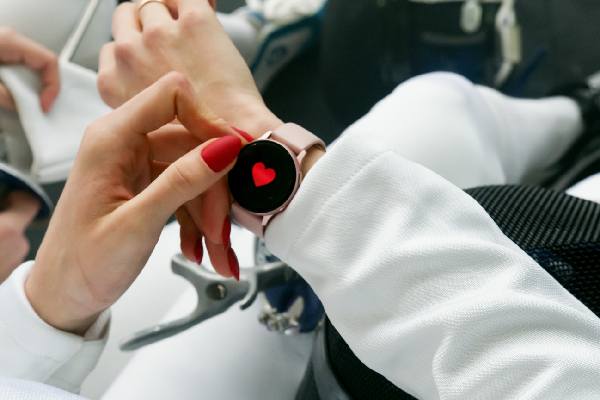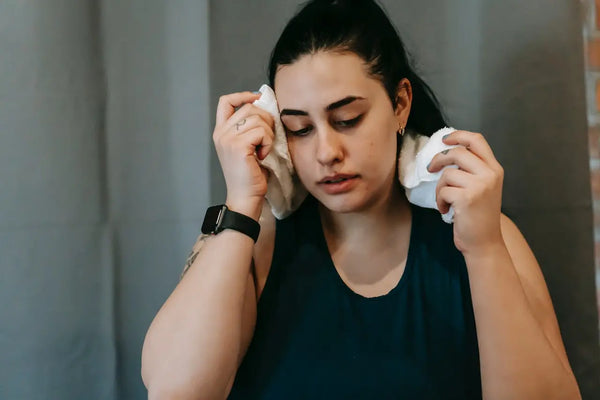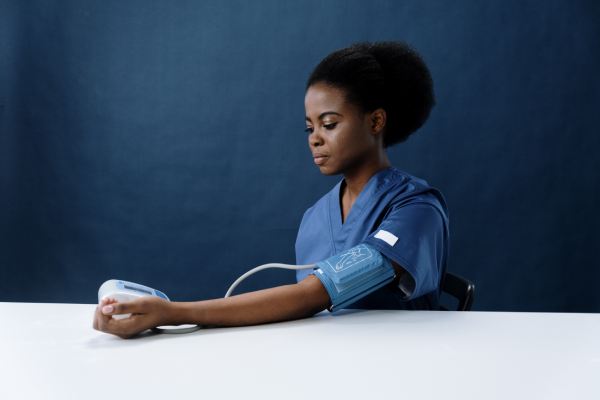
Can a smartwatch save your life?
How smartwatches are becoming important diagnostic aids.
Many of us are used to our smartwatches letting us know we need more sleep, sending us a little badge if we beat our running record, or congratulating us on hitting 10,000 steps for the day.
But what about a smart watch or bracelet that could alert you to a serious health problem that could ultimately save your life?
Thanks to advances in sensors and accessories and improved software for deep research, a future where our smart devices will become as important as our doctors is not far off.
Apple Watch saved my life last night
We spoke to Rachel Fisher, a customer service specialist for recycling company Bywaters, whose life was potentially saved by a smartwatch last year.
“On a whim, I decided to check my heart rate to see what my resting heart rate was using the Apple Watch. To my shock, it said it was 140/150 bpm (average is between 70 and 100 bpm),” Fisher said.
"I thought it would be a one-time thing, but over time, I realized that my heart never slows down," she said. "So they did a blood test and it turned out I had an overactive thyroid, so severe that the doctor told me I could have a heart attack at any moment. I am now on beta blockers and other drugs that slow my heart down.
Fisher's story is remarkable, but she is not alone. Stories like this one, about how a smartwatch alerted users to a problem that turned out to be life-threatening, are increasingly making headlines.
For example, last October, podcast producer and reporter James Green from New York was wearing an Apple Watch , prompting him to seek emergency medical attention after noticing a spike in his resting heart rate. He later found out it was due to a blood clot in his lungs.
According to you, these may be rare cases. But recent studies have found that heart rate data collected by devices like the Apple Watch and Fitbit Ionic is almost as accurate as a medical electrocardiogram test . So it stands to reason that people with no previous medical problems can find problems they didn't know they had, like an overactive thyroid, an irregular heartbeat or a blood clot, with the help of these smart devices. And it's likely to become even more common as technology advances.
From counting steps to saving lives

When smartwatches and wristbands first hit the market, the data they collected was pretty simple, like counting steps and how often you move at night. This was because most devices used an accelerometer that only does a good job of detecting motion.
Nowadays, many devices are equipped with sensors that can collect all kinds of data about our health, activity and lifestyle.
From tracking stress levels with accelerometer breathing tracking to monitoring VO2 max (the measurement of the amount of oxygen we use up) while exercising to gauge your fitness levels, all the bases are covered.
This means that they do much more than the advanced pedometers of the past, and in some cases have become as useful and smart as some of the medical devices you'd normally only find in hospitals.
We spoke to Mike Feibus, principal analyst at market research company FeibusTech , who told us: “In 2017, we finally got to the point where even the worst heart rate sensors in wearables were pretty decent. This is an important milestone. Because it means companies that develop biometrics can accept a minimum threshold of accuracy.
We asked Dr Keith Grimes , GP and consultant, why heart rate is so important.
"In the gym, heart rate monitoring has obvious training benefits, but when it comes to heart rate and health, it's a bit more complicated," he explained.
"As a doctor, I am interested in extreme values of the heart rate (too high - tachycardia or too low - bradycardia) as well as rhythm disorders (arrhythmias). Consumer heart monitors claim to be able to identify arrhythmias such as atrial fibrillation (AF), in which the heart beats irregularly. If detected early and treated with blood-thinning drugs, it can reduce the risk of strokes.
Monitoring your heart with new technology

There are two main ways to measure exactly how your heart is functioning and they are photoplethysmography (PPG) and electrocardiography (EKG or ECG).
Most smartwatches use photoplethysmography. This technology works because blood is red, reflects red light and absorbs green light. This means that with the help of flashing green LEDs, you can accurately detect how much blood is flowing through your wrist.
The more blood, the more green light is absorbed, so you can get an accurate reading of beats per minute as well as heart rate variability.
Both Fitbit and Apple, two of the most popular brands of smartwatches and bracelets capable of tracking heart rate, use photoplethysmography for this purpose. Many other brands also use it, but not always on the wrist. For example, both Polar and Wahoo have PPG armbands that they claim are more accurate because of the position of the veins in the arm. The Moov HR Sweat does the same but uses headbands and claims the same.
Although most smartwatch and fitness band companies use a similar kind of optical sensor technology, they are working on improving their algorithms to provide more useful and accurate insights to the user.
Let's not forget that there has long been technology in medical circles that can also track heart rate extremely accurately. If a doctor or cardiologist wants to get a better look at how someone's heart is working, they often use an electrocardiogram (or EKG) machine.
Unlike PPG, EKG technology is all about reading electrical signals collected at various points on your body using a series of sensors. These electrical signals provide information about the heart's rhythm and its electrical activity, which can be used to detect problems such as arrhythmias, heart disease, or cardiomyopathy.
Although most mass trackers use PPG, a number use ECG technology, such as the Polar H10. There is a good chance that Apple will somehow incorporate ECG technology into its Apple Watch in the next version.
There is much scientific literature debating whether PPG or EKG technology is more accurate in detecting heart problems. A 2017 study published in the Journal of the American College of Cardiology found that PPG was as accurate as an EKG when it came to tracking heart rate and bradyarrhythmias (slow heartbeats), but not as accurate when identifying tachycardia (rapid heart rate).
In short, the EKG (or EKG) is generally considered more accurate, which makes sense given that trackers using PPG are largely designed primarily to help people achieve fitness goals, not to alert them to serious medical conditions.
But EKG equipment can be more expensive and more difficult to carry. This means that even though PPG technology isn't always that reliable, incorporating it into more mainstream consumer devices could still make it very important and potentially life-saving.
It is important to keep in mind that false readings can have very bad consequences, especially when they are seen not by doctors but by ordinary users.
"We need to make sure that consumer heart rate devices are accurate and that they really help people manage their health," Dr. Grimes told us.
“A good example would be a patient taking a beta-blocker for heart disease. If the dose is too high, their heart rate will decrease and they may experience side effects. Using a consumer-facing device that is inaccurate can lead to false reassurance or unnecessary panic.
Using artificial intelligence to better understand the body
Current sensors alone can tell us a lot. That's why a number of companies are working on additional apps, deep learning software and accessories that make the data collected by the sensors more useful by comparing them to averages and past data and making better predictions.
For example, last year the US Food and Drug Administration (FDA) cleared AliveCor's KardiaBand , making it the first true medical accessory for the Apple Watch. It consists of a watch strap that is a portable electrocardiogram (ECG) reader.
So far, the Apple Watch has proven capable of tracking heart rate using PPG, but what the KardiaBand does is allow a GP to be alerted to abnormal heartbeats, as well as atrial fibrillation, by comparing current data with data monitored in the past .
We spoke with Eric Topol, executive vice president and professor of molecular medicine, The Scripps Research Institute , who agreed that the algorithms used by people like AliveCor are the most valuable.
"Heart rate sensors by themselves aren't very helpful," Topol told us. "But they can now be integrated with artificial intelligence to detect a heart rhythm problem, such as atrial fibrillation, which can be a major risk factor for stroke."
Feibus of FeibusTech explained that AliveCor's technology is a great example of how we can use what smart wearables can offer us right now, despite their limitations. “Physicians trust AliveCor because their first product was a pocket EKG. We hope AliveCor will point the medical community in the right direction,” he added.
But additional accessories are not always necessary. Last year, the team behind the Cardiogram app for Apple Watch and Android Wear teamed up with the American Heart Association and found that using a deep neural network called DeepHeart, data from Fitbit and Apple Watch devices could be used to detect both hypertension, and sleep apnea.
"This study is one of the first to show that artificial intelligence can be trained to perform tasks that doctors cannot perform - analyzing a week's worth of wearable data and recognizing patterns associated with hypertension and sleep apnea that are invisible to the naked eye,” Cardiogram co-founder Brandon Ballinger told us.
"This allows both artificial and human intelligence to play to their strengths—for AI to sift through large data sets to discern hidden patterns, and for humans to care with empathy and nuance."
These examples are just the beginning. Apple made its health-tech intentions clear in late 2017 when it announced plans to partner with Stanford Medicine to collect irregular heartbeat data and notify users who may be experiencing atrial fibrillation.
The move has understandably led many to predict that the tech industry is firmly focused on creating products, devices and services that give ordinary consumers better insight into their own health than ever before, which is a very good thing, especially for the elderly .
Take your health into your own hands

We are in an exciting time where smart watches and bracelets are quickly becoming important diagnostic tools not only for medical professionals but for everyone else as well.
"Healthcare is evolving from the paternalistic 'Doctor knows best' of the past to a world where the patient has more control," Dr. Grimes tells us. "Consumer technology is helping to meet the needs of today's patients, but we must be careful that what is promised is matched with accuracy."
Mike Febus believes the next challenge will be to convince the medical community that smart wearables have great value. "The biggest challenge is how to integrate the information from these devices into the workflow of professionals," he said.
Grimes added: "If we can find a way to turn the vast amount of data generated by these devices into useful information that can be used by both patients and doctors, then the future is quite bright." If we get it wrong, we will flood an already strained health service with unnecessarily anxious people.”
Let's hope we do well. Thus, as smartwatch and bracelet companies work to build more accurate sensors, integrate neural networks, and consult with healthcare professionals, these professionals will be better equipped to care for us, and we will be able to we monitor our own health better.
Source: Techradar
